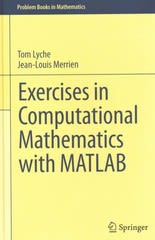Question
A consulting firm was hired to conduct a survey on people living in New York City. The survey was completed monthly for six months by
A consulting firm was hired to conduct a survey on people living in New York City. The survey was completed monthly for six months by 445 randomly-selected people in different boroughs. There were a number of items on the survey, but six basic biographical items will be studied for this exercise. The data for the people surveyed in one of these monthly surveys can be found in the Excel fileSURVEYDownload SURVEY. The variables that were used for the basic biographical data are found on the last page of the exercise.
In this exercise, some of the estimation techniques presented in the module will be applied to the New York survey results. You may assume that these respondents represent a simple random sample of all potential respondents within the community, and that the population is large enough that application of the finite population correction would not make an appreciable difference in the results.
New York City governmental agency personnel like to have point estimates regarding variables describing the biographical information of the people living within the different boroughs. It is very helpful for them to have some idea regarding the likely accuracy of these estimates as well. Therein lies the benefit of the techniques presented in this module and applied here.
- Item A in the description of the data collection instrument lists variables 1 through 5, which represent the respondent's general attitude toward each of the five boroughs. Each of these variables has numerically equal distances between the possible responses, and for purposes of analysis they may be considered to be of the interval scale of measurement.
- Determine the point estimate, and then construct the 95% confidence interval for 1= the average attitude toward Manhattan.
- Repeat part (a) for 2 through 5, the average attitudes toward Brooklyn, Queens, The Bronx and Staten Island, respectively.
- Given the breakdown of responses for variable 6 (highest level of education), determine the point estimate, and then construct the 95% confidence interval for p6= the population proportion of doctoral degrees.
- Given the breakdown of responses for variable 7 (marital status of respondent), determine the point estimate, and then construct the 95% confidence interval for p7 = the population proportion in the "single or other" category.
- Assume the governmental agencies requested estimates of the mean attitudes towards each borough with a margin of error of 0.05 for each borough. If the governmental agency personnel want to have 95% confidence that the sample mean will fall within this margin of error, how large should the sample sizes be for each borough?
NOTE: You MUST submit your Excel file with your report. This will allow you to qualify for consideration for partial credit if any errors are found in your report.
A. General Attitude toward Each Borough (Variables 1-5)
1.Manhattan | 2.Brooklyn | 3.Queens | 4.The Bronx | 5.Staten Island | |
Like Very Much | (5) | (5) | (5) | (5) | (5) |
Like | (4) | (4) | (4) | (4) | (4) |
Neutral | (3) | (3) | (3) | (3) | (3) |
Dislike | (2) | (2) | (2) | (2) | (2) |
Dislike Very Much | (1) | (1) | (1) | (1) | (1) |
B. Information about the Respondent (Variables 6-7)
- What is your highest level of education?
(1) = Did not complete High school
(2) = High school degree/GED(3) = Associate's degree
(4) = Bachelor's degree
(5) = Master's degree
(6) = Doctoral degree
Marital Status: (1) = Married (2) = Single or other
Step by Step Solution
There are 3 Steps involved in it
Step: 1

Get Instant Access to Expert-Tailored Solutions
See step-by-step solutions with expert insights and AI powered tools for academic success
Step: 2

Step: 3

Ace Your Homework with AI
Get the answers you need in no time with our AI-driven, step-by-step assistance
Get Started


